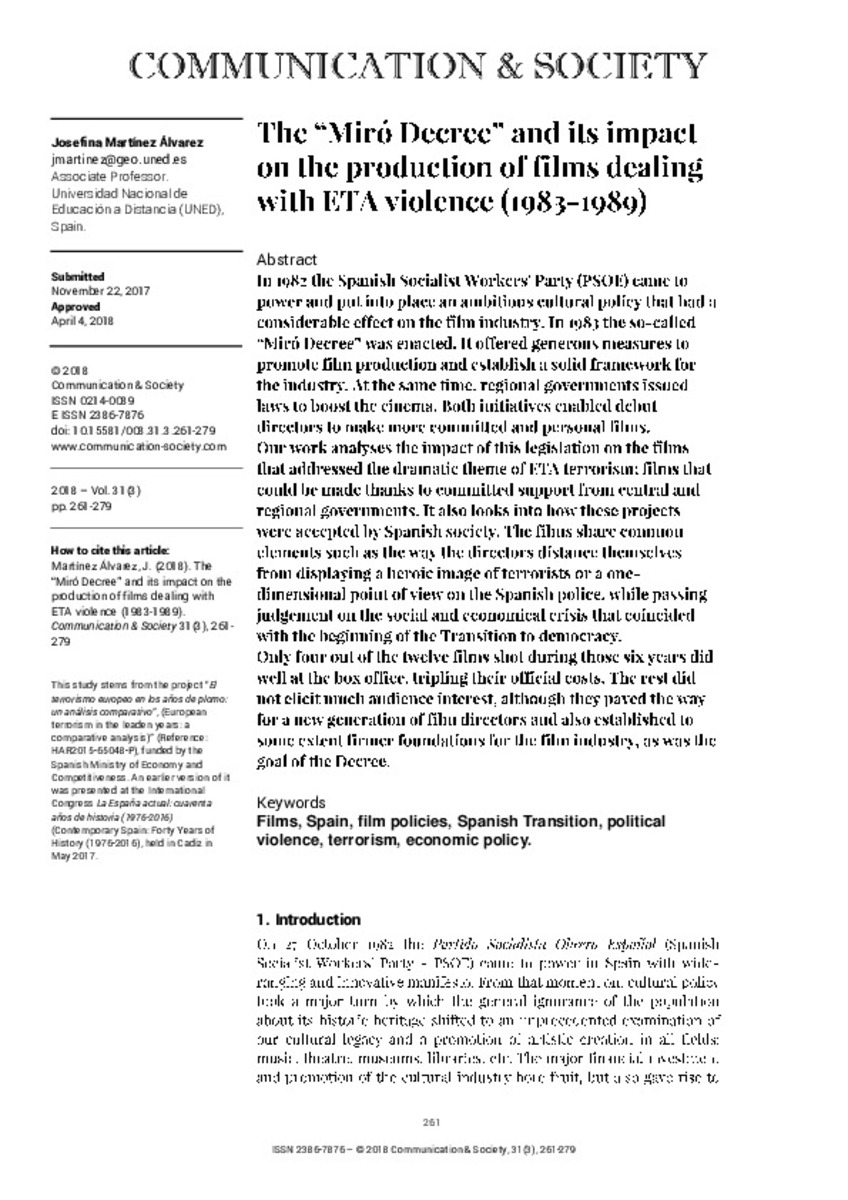Full metadata record
| DC Field | Value | Language |
|---|---|---|
| dc.creator | Martínez-Álvarez, J. (Josefina) | - |
| dc.date.accessioned | 2018-11-13T10:47:01Z | - |
| dc.date.available | 2018-11-13T10:47:01Z | - |
| dc.date.issued | 2018 | - |
| dc.identifier.citation | Martínez-Álvarez, J. (Josefina). "The “Miró Decree” and its impact on the production of films dealing with ETA violence (1983-1989)". Communication & Society. 31 (3), 2018, 261 - 279 | es |
| dc.identifier.issn | 2386-7876 | - |
| dc.identifier.uri | https://hdl.handle.net/10171/55794 | - |
| dc.description.abstract | In 1982 the Spanish Socialist Workers' Party (PSOE) came to power and put into place an ambitious cultural policy that had a considerable effect on the film industry. In 1983 the so-called “Miró Decree” was enacted. It offered generous measures to promote film production and establish a solid framework for the industry. At the same time, regional governments issued laws to boost the cinema. Both initiatives enabled debut directors to make more committed and personal films. Our work analyses the impact of this legislation on the films that addressed the dramatic theme of ETA terrorism; films that could be made thanks to committed support from central and regional governments. It also looks into how these projects were accepted by Spanish society. The films share common elements such as the way the directors distance themselves from displaying a heroic image of terrorists or a one-dimensional point of view on the Spanish police, while passing judgement on the social and economical crisis that coincided with the beginning of the Transition to democracy. Only four out of the twelve films shot during those six years did well at the box office, tripling their official costs. The rest did not elicit much audience interest, although they paved the way for a new generation of film directors and also established to some extent firmer foundations for the film industry, as was the goal of the Decree. | es_ES |
| dc.description.abstract | En 1982, cuando el Partido Socialista Obrero Español (PSOE) alcanzó el gobierno de España, puso en marcha una ambiciosa política cultural que incidió considerablemente en la industria cinematográfica. En 1983 se publicaba un real decreto, el “Decreto Miró”, que ofrecía unas generosas medidas de fomento a la producción cinematográfica, con la intención de establecer un sólido tejido industrial. A su vez las Administraciones autonómicas dictaron normas de fomento; ambas iniciativas permitieron a directores noveles realizar películas más comprometidas y personales. A lo largo de este estudio se analiza la repercusión de estas medidas en las películas que abordaron un drama tan sensible como fue el terrorismo de ETA; filmes que vieron la luz gracias a la apuesta decidida de las Administraciones. Asimismo se analiza la aceptación, por parte de la sociedad española, de estas propuestas. En estas cintas existen elementos comunes como el alejamiento de los directores de la imagen heroica de los terroristas o la monolítica visión sobre las fuerzas del orden, a la vez que se denuncia la crisis social y económica de los inicios de la Transición. De las doce películas filmadas durante este sexenio, solo cuatro obtuvieron buenos resultados en taquilla, triplicando con su recaudación los costes declarados. Las demás se alejaron del interés del público, aunque propiciaron el establecimiento de una cantera de nuevos directores y ampliaron, de alguna manera, el tejido industrial cinematográfico, tal y como pretendía el Real Decreto. | es_ES |
| dc.language.iso | eng | es_ES |
| dc.publisher | Servicio de Publicaciones de la Universidad de Navarra | es_ES |
| dc.rights | info:eu-repo/semantics/openAccess | es_ES |
| dc.subject | Films | es_ES |
| dc.subject | Spain | es_ES |
| dc.subject | Film policies | es_ES |
| dc.subject | Spanish Transition | es_ES |
| dc.subject | Political violence | es_ES |
| dc.subject | Terrorism | es_ES |
| dc.subject | Economic policy | es_ES |
| dc.title | The “Miró Decree” and its impact on the production of films dealing with ETA violence (1983-1989) | es_ES |
| dc.title.alternative | El “Decreto Miró” y su repercusión en la producción de películas relacionadas con la violencia de ETA (1983-1989) | es_ES |
| dc.type | info:eu-repo/semantics/article | es_ES |
| dc.publisher.place | Pamplona | es_ES |
| dc.identifier.doi | 10.15581/003.31.3.261-278 | es_ES |
| dadun.citation.endingPage | 279 | es_ES |
| dadun.citation.number | 3 | es_ES |
| dadun.citation.publicationName | Communication & Society | es_ES |
| dadun.citation.startingPage | 261 | es_ES |
| dadun.citation.volume | 31 | es_ES |
Files in This Item:
Statistics and impact
Items in Dadun are protected by copyright, with all rights reserved, unless otherwise indicated.






